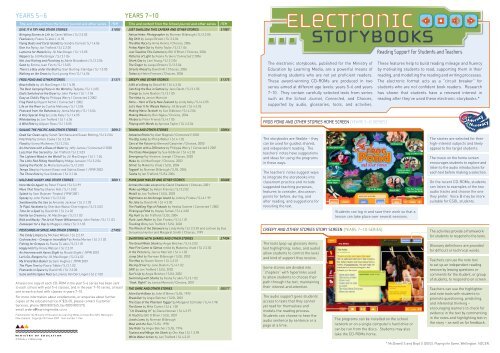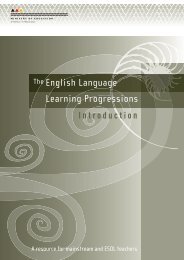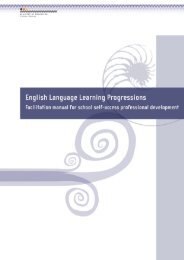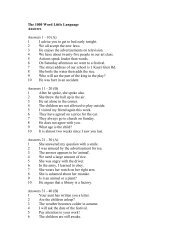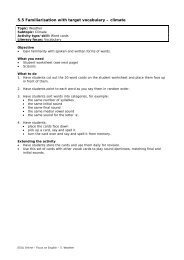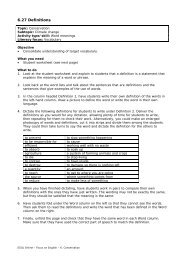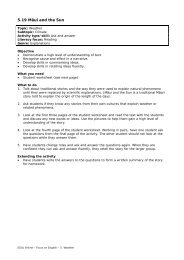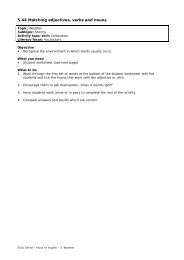cdrom-pamphlet - ESOL - Literacy Online
cdrom-pamphlet - ESOL - Literacy Online
cdrom-pamphlet - ESOL - Literacy Online
Create successful ePaper yourself
Turn your PDF publications into a flip-book with our unique Google optimized e-Paper software.
Years 5–6<br />
Title and content from the School Journal and other series<br />
Item<br />
Give It a Try and other stories 31892<br />
Bringing Stories to Life by Caren Wilton / SJ 2.3.02<br />
Fearless by Feana Tu‘akoi / JJ 35<br />
Flying Boats and Coral Islands by Sandra Carrod / SJ 1.4.06<br />
Give It a Try by Jan Trafford / SJ 2.2.00<br />
Lanterns for Matariki by Jill MacGregor / SJ 1.3.05<br />
Nippers by Jill MacGregor / SJ 2.1.06<br />
Not Just Kicking and Punching by Adele Broadbent / SJ 2.2.06<br />
Sand by Emma Jean Finch / SJ 1.5.05<br />
There’s a Boy under the Bed! by Sian Burling-Claridge / SJ 1.5.05<br />
Walking on the Grass by Sun Lyoung Kim / SJ 1.4.06<br />
Frog Pond and other stories 31371<br />
Beach Balls by Jill MacGregor / SJ 1.5.05<br />
The Best Camping Place in the World by Tadpole / SJ 1.2.05<br />
Dad’s Switched on the Dryer by John Parker / SJ 1.1.04<br />
Easy as Child’s Play by Philippa Werry / Connected 2 2002<br />
Frog Pond by Rupert Alchin / Connected 1 2002<br />
Life on the River by Cushla Mahoney / SJ 1.3.04<br />
Postcard from the Bahamas by Jeena Murphy / SJ 1.5.04<br />
A Very Special Frog by Lindy Kelly / SJ 1.4.05<br />
Whitebaiting by Jan Trafford / SJ 1.4.04<br />
A Wild Ride by Allyson Ross / SJ 1.5.05<br />
Sailing the Pacific and other stories 30912<br />
Dead Car Clean-up by Sarah Tamihana and Susan Botting / SJ 2.2.04<br />
Fire! Fire! by Simon Cooke / SJ 3.2.04<br />
Flood by Sonny Mulheron / SJ 2.2.04<br />
An Interview with a Glass of Water by Jeffy James / Connected 2 2002<br />
Less than One Second by Jan Trafford / SJ 2.3.03<br />
The Lightest Wood in the World by Jill MacGregor / SJ 1.1.04<br />
The Little Red Riding Hood Rap by Midge Janssen / SJ 2.2.04<br />
Sailing the Pacific by Maria Samuela / SJ 2.3.03<br />
Tampa Story by Hussain Ewazi and Sakina Ewazi / JYPW 2003<br />
The Three Kete by Sue Gibbison / SJ 3.1.04<br />
Wild and Wacky and other stories 30011<br />
Here We Go Again! by Peter Friend / SJ 3.2.99<br />
Move That Tree! by Sharon Holt / SJ 1.3.02<br />
Splash by Sam Bojesen-Trepka/ JYPW 2001<br />
Spooky by John Parker / SJ 2.3.02<br />
Swallowed by the Sea by Amanda Jackson / SJ 2.1.03<br />
Te Pupu Harakeke by Sheridan Waitai-Cherrington / SJ 2.3.03<br />
Time for a Spell by David Hill / SJ 2.4.02<br />
Vanilla Ice Cream by Jill MacGregor / SJ 2.1.03<br />
Wild and Wacky: The Art of Fraser Williamson by John Parker / SJ 1.1.03<br />
Zookeeper for a Day by Maggie Lilleby / SJ 3.1.03<br />
Postcards in Space and other stories 27493<br />
The Cindy Limpics by Michael Wilson / SJ 2.2.01<br />
Cockroaches – Creepy or Incredible by Amba Morton / SJ 3.1.02<br />
Fishing for Octopus by Feana Tu‘akoi / SJ 2.1.01<br />
Happy Holi! by Hilary Watson / SJ 2.2.01<br />
An Interview with Aaron Slight by Nicole Slight / JYPW 2001<br />
Let’s Go, Rangers! by Jill MacGregor / SJ 2.4.02<br />
My Friend Ben Baxter by Sam Hughes / JYPW 2001<br />
The Plum Tree by Paora Tibble / SJ 2.1.02<br />
Postcards in Space by David Hill / SJ 3.3.00<br />
Suzie and the Space Nuts by Lorenzo Van Der Lingen / SJ 2.1.00<br />
At least one copy of each CD-ROM in the year 5–6 series has been sent<br />
to each school with year 5–6 classes, and in the year 7–10 series, at least<br />
one to each school with classes in years 7–10.<br />
For more information about entitlements, or enquiries about further<br />
copies at the education price of $26.00, please contact Customer<br />
Services, phone 0800 800 565, fax 0800 800 570,<br />
email orders@learningmedia.co.nz<br />
Published for the Ministry of Education by Learning Media Limited, Box 3293, Wellington,<br />
New Zealand. Copyright © Crown 2007. Item number 11166<br />
Years 7–10<br />
Title and content from the School Journal and other series<br />
Item<br />
Just Swallow This Camera and other stories 31987<br />
Adrian Heke: Photographer by Norman Bilbrough / SJ 3.3.05<br />
Big Shift by Jacqui Brown / SJ 3.2.06<br />
The Bike Race by Anna Kenna / Choices, 2006<br />
Friday Night Out by Kathy Taylor / SJ 3.1.06<br />
Just Swallow This Camera by Bill O’Brien / Choices, 2006<br />
Patterns of Light by Feana Tu akoi / Connected 2 2006<br />
Shark Day by Lani Young / SJ 3.2.06<br />
The Singer by Jacqui Brown / SJ 3.3.04<br />
Streets Ahead by David Hill / Choices, 2006<br />
Tattoo by Helen Frances / Choices, 2006<br />
Creepy and other stories 31375<br />
A Bit of a Bang by David Hill / SJ 4.3.04<br />
Catching the Bus in Samoa by Jane Davitt / SJ 3.1.05<br />
Creepy by Jane Buxton / SJ 3.1.05<br />
The Haka by Janice Marriott<br />
Kehu – Hero of Early New Zealand by Lindy Kelly / SJ 4.2.05<br />
Let’s Hear It for Waiata Reka by Jill Brasell / SJ 4.3.05<br />
Making Manu Taratahi by Sue Gibbison / SJ 4.2.06<br />
Making Waves by Ben Ngaia / Choices, 2004<br />
Phobia by Peter Friend / SJ 4.1.05<br />
Playing with Words by Apirana Taylor / SJ 4.3.04<br />
Taiaha and other stories 30864<br />
Aotearoa Rocks! by Alan Bagnall / Connected 2 2003<br />
The Big Jump by Philip Waller / SJ 4.1.02<br />
Cars of the Future by Bernard Carpinter / Choices, 2000<br />
Champion with a Difference by Philippa Werry / Connected 2 2001<br />
The Class Newspaper by Sue Gibbison / SJ 4.2.03<br />
Emergency! by Vivienne Joseph / Choices, 2002<br />
Maka by Jill MacGregor / Choices, 2003<br />
Shine! by Makerita Urale / SJSL 2004<br />
Tagged! by Norman Bilbrough / SJSL 2004<br />
Taiaha by Ian Trafford / SJSL 2004<br />
Punk Junk Mailer and other stories 30088<br />
Across the Lake adapted by David Chadwick / Choices, 2001<br />
Make-up Magic by Helen Frances / SJ 3.2.02<br />
MotoX by Jan Trafford / SJSL 2003<br />
Nightmare on Anchorage Island by Johnny Frisbie / SJ 4.1.99<br />
No Joke by David Hill / SJ 4.3.00<br />
The Paddling Pigs of Fakaofo by Healoa Sosene / Connected 1 2002<br />
Picking up Puha by Hayley Tamati / SJ 4.3.00<br />
Pig Hunt by Ian Trafford / SJSL 2004<br />
Punk Junk Mailer by Don Franks / SJ 4.1.01<br />
Trucking On by Ian Trafford / SJSL 2003<br />
The Wreck of the Delaware by Lindy Kelly / SJ 3.3.03 and cartoon by Gus<br />
Sinaumea Hunter and Margaret Smith / Choices, 1999<br />
Swimming with Sharks and other stories 27494<br />
The Great White Shark by Angie Belcher / SJ 4.2.02<br />
How Fire Came to Samoa retold by Makerita Urale / SJ 2.2.02<br />
In the Picture by Janice Marriott / SJ 4.1.03<br />
Jump Shot by Norman Bilbrough / SJSL 2002<br />
The Moa by Steven Storer / SJ 4.3.01<br />
Racing Driver by Jane Buxton / SJ 4.1.02<br />
SK8! by Jan Trafford / SJSL 2002<br />
Surf’s Up by Angie Belcher / SJSL 2002<br />
Swimming with Sharks by Feana Tu akoi / SJ 3.1.02<br />
“Yeah, Right!” by Janice Marriott / Choices, 2001<br />
The Game and other stories 26577<br />
Alien Earth Base by John O’Brien / SJSL 1992<br />
BreakOut! by Angie Belcher / SJSL 2001<br />
The Case of the Phantom Tagger by Margaret Schroder / SJ 4.1.98<br />
The Game by Mike Carter / SJ 4.1.00<br />
“I’m Dreading It!” by Diana Noonan / SJ 4.3.97<br />
In Touch by Bill O’Brien / SJSL 2001<br />
Jonah Lomu by Norman Bilbrough<br />
Maui and the Sun / SJSL 1998<br />
Sky Rider by Angie Belcher / SJSL 1996<br />
Tuatara and Mango the Shark by Oho Kaa / SJ 1.3.98<br />
White Water Action by Jan Trafford / SJ 4.3.01<br />
The electronic storybooks, published for the Ministry of<br />
Education by Learning Media, are a powerful means of<br />
motivating students who are not yet proficient readers.<br />
These award-winning CD-ROMs are produced in two<br />
series aimed at different age levels: years 5–6 and years<br />
7–10. They contain carefully selected texts from series<br />
such as the School Journal, Connected, and Choices,<br />
supported by audio, glossaries, tools, and activities.<br />
Frog Pond and other stories home screen (Years 5–6 series)<br />
The storybooks are flexible – they<br />
can be used for guided, shared,<br />
and independent reading. The<br />
teachers’ notes have suggestions<br />
and ideas for using the programs<br />
in these ways.<br />
The teachers’ notes suggest ways<br />
to integrate the storybooks into<br />
classroom practice and include<br />
suggested teaching purposes,<br />
features to consider, discussion<br />
points for before, during, and<br />
after reading, and suggestions for<br />
revisiting the text.<br />
Creepy and other stories story screen (Years 7–10 series)<br />
The tools (pop-up glossary items,<br />
text highlighting, notes, and audio)<br />
allow students to control the level<br />
and kind of support they receive.<br />
Some stories are divided into<br />
“chapters” with hyperlinks used<br />
to allow students to choose their<br />
path through the text, maintaining<br />
their interest and attention.<br />
The audio support gives students<br />
access to texts that they cannot<br />
yet read for themselves and<br />
models the reading process.<br />
Students can choose to hear the<br />
audio sentence by sentence or a<br />
page at a time.<br />
Students can log in and save their work so that a<br />
lesson can take place over several sessions.<br />
The programs can be installed on the school<br />
network or on a single computer’s hard drive or<br />
can be run from the discs. Students may also<br />
take the CD-ROMs home.<br />
These features help to build reading mileage and fluency<br />
by motivating students to read, supporting them in their<br />
reading, and modelling the reading and writing processes.<br />
The electronic format acts as a “circuit breaker” for<br />
students who are not confident book readers. Research<br />
has shown that students have a renewed interest in<br />
reading after they’ve used these electronic storybooks.*<br />
The stories are selected for their<br />
high-interest subjects and likely<br />
appeal to the target students.<br />
The music on the home screen<br />
encourages students to explore and<br />
listen to the audio introductions for<br />
each text before making a selection.<br />
On the recent CD-ROMs, students<br />
can listen to examples of the two<br />
audio tracks and choose the one<br />
they prefer. Voice B may be more<br />
suitable for <strong>ESOL</strong> students.<br />
The activities provide a framework<br />
for students to respond to the texts.<br />
Glossary definitions are provided<br />
for difficult or technical words.<br />
Teachers can use the note tool<br />
to set up an independent reading<br />
session by leaving questions or<br />
comments for the student, or group<br />
of students, to respond to on screen.<br />
Teachers can use the highlighter<br />
and note tools with students to<br />
promote questioning, predicting,<br />
and inferential thinking –<br />
encouraging learners to check for<br />
evidence in the text by commenting<br />
in the notes and highlighting text in<br />
the story – as well as for feedback.<br />
* McDowell S and Boyd S (2003). Playing the Game, Wellington: NZCER.
Years 5–6 series<br />
Winner, Education award,<br />
TUANZ 2003<br />
Winner, Best of the Best award and<br />
Education award, TUANZ 2006<br />
Years 7–10 series<br />
Give It a Try<br />
(2007)<br />
Frog Pond<br />
(2006)<br />
Sailing the<br />
Pacific (2005)<br />
Wild and<br />
Wacky (2004)<br />
Postcards<br />
in Space (2003)<br />
The Game<br />
(2002)<br />
Swimming with<br />
Sharks (2003)<br />
Punk Junk<br />
Mailer (2004)<br />
Taiaha<br />
(2005)<br />
Creepy<br />
(2006)<br />
Just Swallow<br />
This Camera (2007)<br />
Activities and features:<br />
M PM PS C<br />
<strong>ESOL</strong> audio track<br />
Activities and features:<br />
M PM PS C<br />
<strong>ESOL</strong> audio track<br />
Activities:<br />
M C PM<br />
Activities:<br />
M C PM<br />
Activities:<br />
M C PM<br />
Activities:<br />
R<br />
Activities:<br />
R<br />
Activities:<br />
R<br />
Activities:<br />
I C R<br />
Activities and features:<br />
C PS I R<br />
<strong>ESOL</strong> audio track<br />
Activities and features:<br />
C PS I R<br />
<strong>ESOL</strong> audio track<br />
Activities<br />
The activities are designed to encourage students to respond to the reading<br />
and to facilitate writing. Most stories have one or two of the following<br />
activities that can be completed after reading.<br />
“It was a hard decision<br />
to choose which to<br />
read first …” Willie<br />
“It wasn’t dull.<br />
It was exciting.<br />
It made you want<br />
to know more<br />
about it.” Afisa<br />
teachers’ notes<br />
Teachers’ notes come with each storybook (as a printed booklet and PDF)<br />
and are designed to help you:<br />
• incorporate the storybooks into your reading programme;<br />
Message (M): students select an image from the story and write a message<br />
to a friend about what they’ve read.<br />
• use the storybooks with your students to encourage them to enjoy<br />
reading and gain confidence and fluency in it;<br />
Poem (PM): students select an image, read an example of an acrostic<br />
poem, then choose to write their own acrostic poem or another kind<br />
of poem.<br />
• develop the comprehension strategies as described in Effective <strong>Literacy</strong><br />
Practice in Years 5 to 8.<br />
The notes for each text include:<br />
Cartoon (called Creator in years 7–10 series) (C): students create a<br />
cartoon using images from the text they’ve been reading. This activity is<br />
designed to support students to recount the story or aspects of it, using the<br />
images as a prompt and point of connection back to the text.<br />
Presentation (called Presenter in years 7–10 series) (PS): supports<br />
students to create a presentation on a subject related to the text they’ve<br />
been reading.<br />
Innovator (I): scaffolds students’ writing by providing a framework or<br />
structure to build upon. As in a parallel writing exercise, the student<br />
reads a text, chooses a new topic, and then writes on that topic using the<br />
structure of the first text by typing over highlighted words.<br />
• suggested teaching purposes;<br />
• features to consider;<br />
• discussion points for before, during, and after reading (with icons to<br />
identify which comprehension strategy is being used);<br />
• suggestions for revisiting the text.<br />
The discussion points and follow-up tasks are suggestions only: you can<br />
set goals and adapt the lessons to suit the needs of your students.<br />
The notes also include instructions for installing and using the programs, some<br />
troubleshooting tips, and contact details for reporting technical problems.<br />
Responder (R): supports students to respond to a text. Each step prompts<br />
the student to make choices or answer questions. The choices they make<br />
and the text they type are pulled together at the end of the activity to<br />
produce a piece of writing, e.g., a sports profile, a newspaper report, a letter<br />
to the editor, a music review, or a letter.<br />
The programs can be installed on the school network, on a single computer’s<br />
hard drive, or run from the discs. Students may also take the CD-ROMs home.<br />
“My literacy programme is now richer because of the links<br />
between the books and the CD-ROMs, which really motivates<br />
my students.”<br />
Further Reading<br />
McDowell, S (2004). “Opening up a New World: Reluctant Readers’ Use of The Game<br />
and other stories”. Set, no. 1, pp. 12–14.<br />
Ministry of Education (2003). Effective <strong>Literacy</strong> Practice in Years 1 to 4. Wellington:<br />
Learning Media.<br />
Ministry of Education (2006). Effective <strong>Literacy</strong> Practice in Years 5 to 8. Wellington:<br />
Learning Media.<br />
“Quality Teaching Using Digital Resources”. Education Now, no. 3, 2004. Wellington:<br />
Learning Media. www.learningmedia.co.nz/nz/online/ednow/issue3


